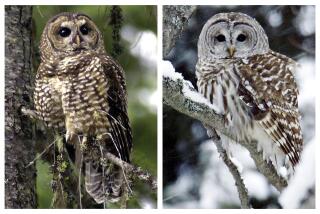Zoo Woos Barn Owls With Nests
PITTSBURGH â Like a real estate agent trying to attract a potential buyer, zookeepers are hoping to repopulate western Pennsylvania with barn owls by offering them spacious nests and a good location to breed.
The loss of nesting sites in recent years, primarily due to a lack of natural habitat and the use of poisons, has practically wiped out the barn-owl population in Pennsylvania and several other states.
But an effort to reintroduce the nocturnal raptors into the region by installing nests at the Pittsburgh Zoo & Aquarium promises to offer a rare sight for local bird watchers. Officials hope the birds also will keep the rodent population around the zoo in check.
Twenty nests were installed around the zooâs 77 acres last August for screech owls and kestrels, which are also known as sparrow hawks. Another five nests--2-foot by 2-foot wooden cubes atop 12-foot poles--will be put up this spring for barn owls.
âWeâll be bringing barn owls back to an area they can thrive,â said zookeeper Mark Browning, an animal trainer by trade and head of the owl project. âTheyâre a wonderful predator so weâll also be able to see how much the barn owls will help us with rodent control.â
Barn owls are crow-sized, golden-colored birds found throughout the world. They once flourished in Pennsylvania, making their nests in large, dead trees and wooden barns, but development has left the owls with fewer places to nest.
âThey like grassy meadows to hunt mice and we have changed their habitat,â said Sally Conyne, director of citizen science at the National Audubon Society.
Conyne said the use of pesticides and rodenticides likely killed many barn owls when they ate their prey.
Ornithologist Dan Brauning of the state Game Commission estimated there are about 10 nests in any given year across Pennsylvania, a drastic reduction from reports of 10 to 15 years ago, when there were as many as 150 nests.
âBarn owls tend to be listed as special concerns in many states,â he said. âThe state [Pennsylvania] listed it as an at-risk species.â
Browning said he proposed the owl project and received about $1,000 in grants from the zooâs conservation foundation after learning about the benefits of having owls around.
âI became aware that palm oil nut plantations in Southeast Asia were using barn owls for rodent control,â he said. âSo we began a project here to increase the number of screech owls, kestrels and barn owls.â
While the screech owls and kestrels have already begun settling into their new homes, itâs unlikely barn owls will migrate into man-made nests on their own.
Thatâs why the zoo plans to acquire two baby barn owls from the Moraine Preservation Fund, a breed-and-release foundation in western Pennsylvania, and teach them to hunt before releasing them into the nests.
âItâs been shown in studies by ornithologists that you can increase natural densities of certain birds by providing nest boxes for them, as long as there is a sufficient amount of available food,â Browning said.
In time, officials hope that the owls will begin to breed and repopulate the area. Browning plans to track their effectiveness in controlling the rodent population and teach other zoos to maintain similar programs.
The National Audubon Society encourages reintroduction programs like one at the Pittsburgh Zoo. Conyne said similar efforts to put up nests in Delaware, Florida and New Jersey have had great success.
More to Read
Sign up for Essential California
The most important California stories and recommendations in your inbox every morning.
You may occasionally receive promotional content from the Los Angeles Times.









